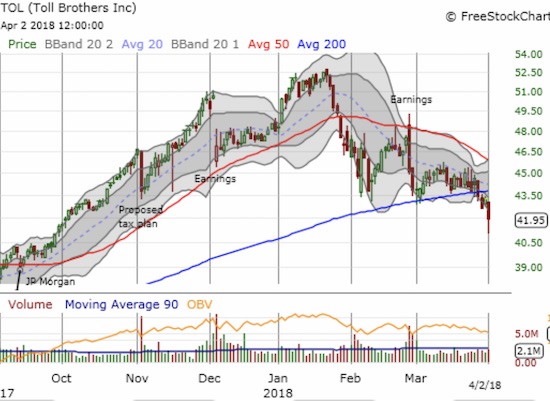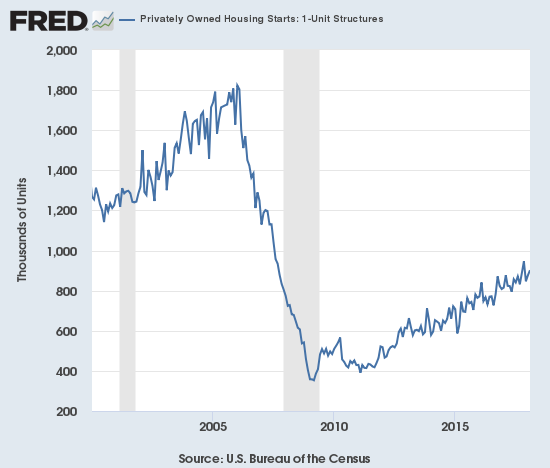The last Housing Market Review covered data reported in February, 2018 for January, 2018. At the time, I connected the dots on the bearish implications of converging technicals and fundamentals. The iShares US Home Construction ETF (ITB) actually managed to hold onto support at its 200-day moving average…until today. So not only is the seasonal trade on home builders busted, but also the home builder index has unfortunately confirmed a bearish turn in this trading cycle.

The iShares US Home Construction ETF (ITB) lost 3.4% and ended the day at a new 5-month low.
The broken 200DMA support (and declining 50DMA) means I will soon liquidate most of my remaining positions in home builders. I am not opening the escape hatch wide open because the housing data in February held steady. Moreover, I read through the latest earnings from KB Home (KBH) and found reasons for encouragement. Whenever my short-term read on the market turns bullish, KBH will likely be the only (new) home builder I buy.
KBH reported strong earnings that the market quickly faded. The action has been quite a turn-around from the near parabolic euphoria that coincided with KBH’s January earnings report. KBH sold off so badly from a major gap that the stock erased the entire breakout from November. March earnings were initially greeted with a celebratory gap up, but sellers, perhaps learning lessons from January earnings, quickly scrambled for the exits. Today KBH lost 2.2% but managed to somehow hold its 200DMA support. I will cover KBH earnings in detail in another post.

KB Home (KBH) is facing down a squeeze from a downtrending 50DMA and an uptrending 200DMA. March earnings failed to turn the tide.
One home builder is still trying to cling to bullish territory: LGI Homes (LGIH). Recall that LGIH increased guidance during its February earnings report and still sold off sharply. Until today’s 5.6% whopping loss, LGIH looked like it had bullishly confirmed a 50DMA breakout. LGIH could become a major market tell.

LGI Homes (LGIH) lost its entire 50DMA breakout gains in one day’s trading action. Can it hold onto a bullish positioning?
On the negative side, Toll Brothers (TOL) flashed a warning sign last week when it closed below its 200DMA support. Today’s 3.0% loss confirms the breakout AND confirms the major fade from February earnings.

Toll Brothers (TOL) closed at a 6-month low as it confirmed a very bearish breakdown.
Going forward, I have greatly tempered my expectations for the next few months during which home builders will finish limping through a period that is supposed to deliver relative strength against the S&P 500 (SPY).
New Residential Construction (Housing Starts) – February, 2018
Single-family housing starts for January were not revised and stayed at 877,000. February starts increased month-over-month by 2.9% to 902,000. On an annual basis, single-family housing starts increased 2.9%, representing the smallest annual gain since October, 2017 at 1.8%.

The uptrend for housing starts looks good-to-go again with February’s small increase off the bottom of the uptrend channel.
Source: US. Bureau of the Census, Privately Owned Housing Starts: 1-Unit Structures [HOUST1F], retrieved from FRED, Federal Reserve Bank of St. Louis, March 16, 2018.
Over the last six months, regional year-over-year changes in starts have exhibited wide dispersion. The Northeast, Midwest, South, and West each changed -4.5%, -36.8%, 8.7%, and 24.6% year-over-year respectively in February. The West delivered very strong growth once again as builders are clearly in a rush to serve a thirsting market. January’s 38.0% leap for the West was what I believe by far the largest year-over-year gain in housing starts for the region in a very long time.
Existing Home Sales – February, 2018
The existing home sales numbers for February, 2018 had a more favorable comparison than the previous month given a year ago sales took a steep dip off what was then a post-recession high. The end of a 2-month sales decline softens a bit the alarm bells from my previous Housing Market Review.











Leave A Comment